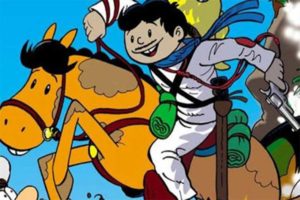
ELPIDIO VALDÉS, PERSONAJE ANIMADO DEL REFRANERO POPULAR CUBANO, HOY ENVEJECE. PHOTOS.
Elpidio Valdés es un personaje de dibujos animados y cómic, protagonista de varios largometrajes, cortos y tiras homónimas. Fue creado en 1970 por el dibujante y cineasta cubano Juan Padrón, considerado el padre de la animación cinematográfica cubana y director de los tres primeros largometrajes de animación producidos por el Instituto Cubano del Arte e Industria Cinematográficos.
Elpidio Valdés es un coronel mambí que lucha por la liberación de su patria del colonialismo español, comandando un escuadrón de caballería, y representa a los campesinos cubanos en el Ejército libertador del siglo XIX.
Debe su nombre a Cecilia Valdés, protagonista cubana de una novela del siglo XIX.
Elpidio Valdés pretendía fortalecer entre la niñez y la juventud cubana una particular visión estatal de una supuesta expresión auténtica de los personajes de la nacionalidad cubana.
ELPIDIO VALDES HOY
Varias generaciones de cubanos hemos crecido mirando los dibujos animados basados en las peripecias de Elpidio Valdés. Mambí, simpático y popular, el personaje ha legado al refranero popular varias frases legendarias y algunas bromas repetidas hasta el cansancio. Dispuesto a aniquilar a los españoles a golpe de machete, nacionalista hasta el tuétano y reivindicador de una versión de la historia apegada al discurso oficial, este insurrecto intentó representar la identidad cubana en su picaresca y rebeldía.

La imagen del artista Denys Almaral da una vuelta inesperada a la iconografía creada por Juan Padrón.
Envejecido, condenado a vender periódicos para sobrevivir y marcado por las penurias económicas, este Elpidio Valdés de la viñeta niega los tintes heroicos que se mostraban en los numerosos cortos y largometrajes que se dedicaron al ocurrente independentista.
La Isla está llena de Elpidio Valdés que piden limosnas y sueñan con ese proyecto de nación que los llevó a los campos para sacudirse el yugo de la metrópoli.
En lugar del país por el que luchó, el Pillo Manigüero pasa sus últimos años en una Cuba donde quienes viven mejor son aquellos que tienen moneda convertible, los sueños de equidad son cosa del pasado y la generación que ayudó a construir el sistema es un “estorbo” para las ansias de monopolio que brotan del Gobierno.
La Isla está llena de Elpidio Valdés que piden limosnas, hacen largas filas para comprar el único pan al que tiene derecho cada día y sueñan con ese proyecto de nación que los llevó a los campos para sacudirse el yugo de una potencia extranjera. Ahora, son súbditos no de la metrópoli, sino del castrismo.



ELPIDIO VALDÉS, AN ANIMATED CHARACTER FROM THE CUBAN POPULAR SAYINGS, IS GETTING OLD TODAY. PHOTOS.
Elpidio Valdés is a cartoon and comic character, the protagonist of several feature films, short films and strips of the same name. He was created in 1970 by the Cuban cartoonist and filmmaker Juan Padrón, considered the father of Cuban film animation and director of the first three animated feature films produced by the Cuban Institute of Cinematographic Art and Industry.
Elpidio Valdés is a mambi colonel who fights for the liberation of his country from Spanish colonialism, commanding a cavalry squadron, and represents the Cuban peasants in the liberating army of the 19th century.
He owes his name to Cecilia Valdés, the Cuban protagonist of a 19th century novel.
Elpidio Valdés intended to strengthen among Cuban children and youth a particular state vision of a supposed authentic expression of the characters of Cuban nationality.
ELPIDIO VALDES TODAY
Several generations of Cubans have grown up watching cartoons based on the adventures of Elpidio Valdés. Mambí, likeable and popular, the character has bequeathed to popular sayings several legendary phrases and some jokes repeated ad nauseam. Ready to annihilate the Spaniards with a machete, nationalist to the core and vindicator of a version of history attached to the official discourse, this rebel tried to represent the Cuban identity in his roguery and rebellion.
The image of the artist Denys Almaral gives an unexpected twist to the iconography created by Juan Padrón.
Aged, condemned to sell newspapers to survive and marked by economic hardship, this Elpidio Valdés of the cartoon denies the heroic overtones that were shown in the numerous short and feature films that were dedicated to the witty independence fighter.
The Island is full of Elpidio Valdés who beg for alms and dream of that national project that took them to the fields to shake off the yoke of the metropolis.
Instead of the country for which he fought, the Pillo Manigüero spends his last years in a Cuba where those who live better are those who have convertible currency, dreams of equity are a thing of the past and the generation that helped build the system is a “hindrance” to the desire for monopoly that springs from the Government.
The Island is full of Elpidio Valdés who beg for alms, stand in long lines to buy the only bread they are entitled to every day and dream of that national project that took them to the fields to shake off the yoke of a foreign power. Now, they are subjects not of the metropolis, but of Castroism.

Agencies/14ymedio/ Yoanis Sánchez, Habana/ YouTube/ Internet Photos/ Arnoldo Varona.
TheCubanhistory.com
THE CUBAN HISTORY, HOLLYWOOD.



